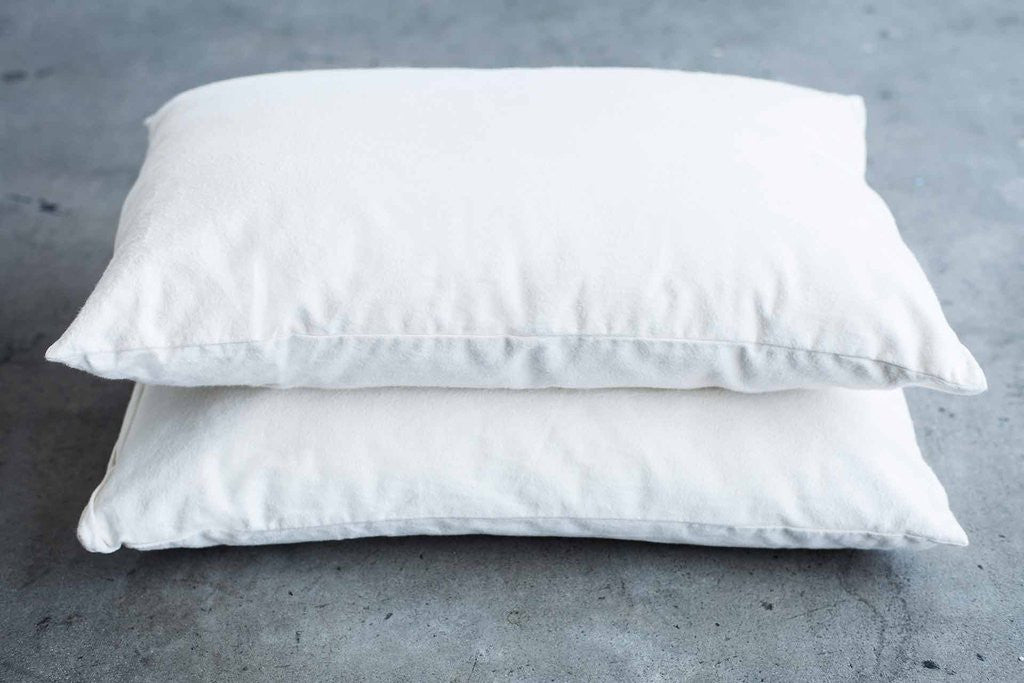We’ve got your “down alternative” right here: kapok!
Hey, sleepyhead! Pillow junkies of all stripes know that the right support pays dividends in restful nights. But excellence is hard to find. Have you tried to locate fluffy stuff that you like better than feathers and still been disappointed?
If you’re like me, you’ve probably spent years running the gamut of natural products and fills, searching for a comfortable pillow to support your neck and noggin. Holistic sleepers have lots of choices in pillow types these days—but the list of cons often outweighs the pros. Goose or duck down provokes allergies. Natural latex can be too firm or too wimpy. Buckwheat hulls slide, offering inconsistent support.
Sure, lots of sleepers love the feel of down but not the allergens, industry negatives, and high price. Whether you have special medical needs or just believe that simpler is better, you’ll want the best organic pillow for the money—not just one more “try” in a long list of trials and errors.
Let’s say you want a natural pillow, but:
- you don’t want to sneeze
- you don’t want to sink
- you do want soft support
I’ll admit, I’m a harsh pillow critic. I have neck, back, and allergy problems, so a pillow that improves—not interferes with—my rest is a must. After trying every type of pillow, from water-filled to shaped and layered, I’ve finally hit on the best organic pillow on the planet. Make this guide your last stop, and you, too, might literally find your dream in the last place you look ... it’s called organic kapok.
INTRODUCING: KAPOK!
Here’s a riddle: what feels like silk, floats on water, and flies through the air with the greatest of ease? It’s kapok—a useful plant fiber with a long history. Once used in flotation devices and baseballs, kapok now provides a cushy yet firm, hypoallergenic stuffing for cervical bed pillows. You know, the things that cradle your neck every night so you can catch some zzzs?
Plant-derived kapok doesn’t break down or invite dust-mite infestation, like goose and duck down feathers do. It’s not as heavy as latex or memory foam. It’s much quieter and softer than buckwheat-hull filling.
Kapok’s Finest Qualities
- Soft
- Pure
- Water repellant
- Resists clumping
- Retains shape for years
- Discourages mildew and pest infestation
- Can be adjusted for customized support
Natural kapok fiber resembles cotton or polyester batting, but is lighter. It slides against itself, offering some “give,” while still stacking up to give great support. So: soft, light, silky, supportive ... what’s not to like? It’s also long lasting and customizable to different sleep styles and body types. And did I mention it’s sustainably grown and harvested?
SUSTAIN THIS: EARTH’S NATURAL PILLOW
Kapok fiber is harvested from the pods of the silk cotton or ceiba tree, by real people, by hand. Tropical kapok trees grow naturally without irrigation or pesticides. When combined with organic cotton casings, cushy kapok fiber produces a truly healthy pillow that does its job well, and lasts for years on end.
Kapok trees have a life cycle of up to hundreds of years! Besides providing your ideal pillow filling, these massive trees preserve soil integrity and water tables. Like other species of trees, they deplete airborne carbon dioxide and pump delicious oxygen into the Earth’s atmosphere.
Compare this type of production with goose and duck down feather processing. Practices such as live plucking that are meant to make animal resources more sustainable can disfigure and harm birds. Not all manufacturers use safe cleaning solutions, which may linger in feathers.
Kapok harvesting and processing, on the other hand, represents a viable industry for people who live in Indonesia, Cambodia, Central America, and other places that silk cotton trees grow. This natural resource lets local populations diversify their agricultural work, providing the means for fair trade—without depleting natural habitats.
ONE SIZE FITS EVERY BODY
Location, location, location: how does your pillow contact your body? Your pillow is not just about propping up your noggin. The goal is to properly align your head , neck, and shoulders so that your spine rests in a healthful position. An organic kapok pillow helps you reach this goal in three ways.
First, kapok fiber is lofty. This elevates your head, so your neck and shoulders do not bear its full weight. Second, kapok is soft against your muscles and vertebrae, allowing you to rest equally comfortably on your back, sides, or stomach.
Third, kapok compacts easily—and springs back just as easily. Pillow makers and consumers can add or remove stuffing to achieve the correct personal balance. This means that a kapok-filled pillow beats other so-called cervical supports, such as water or buckwheat-hull pillows, which just don’t have kapok’s elasticity and density. Buy an organic cotton model with a zipper opening, so you can customize your fit at home. It may be the last pillow you’ll buy for a decade.
